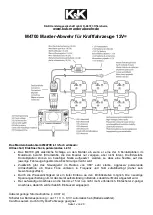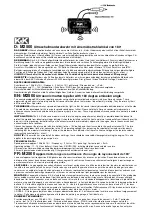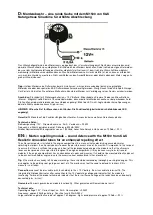
BREAKER POINT ADJUSTMENT—The correct breaker point clearance is
.017". This is adjusted by removing the distributor cap and cranking the engine until the fiber
block on the breaker arm is on the highest point of cam (A). Then loosen lock nut (B)
and turn adjusting screw (C) until the proper
gap is obtained. Tighten lock nut (B) and
re-check setting. Breaker points should be
clean, smooth, and make full contact.
IGNITION TIMING—To check, remove
spark plug from No. 1 (front cylinder) and
place a finger over the spark plug hole. Crank the
engine by pressing the small button on the
rear end of the starting motor solenoid in quick
successive movements after removing the
knurled cap. As air pressure a g a i n s t
t h e f i n g e r i s f e l t , i t i n d i cates
that the piston is coming up on the
compression stroke. Crank the engine
slowly now, until the
U.D.C. 1-8/mark on the front face of the
flywheel lines up with the pointer on the
engine rear support plate. See Fig. 28.
Distributor rotation is
clockwise.
To set
timing loosen clamp screw (G), Fig. 27, and
rotate distributor housing
clockwise
to the
limit of slot in clamping plate (H). Remove the central cable from the distributor cap and
place the bare end
1
/8 inch from the intake manifold. Turn on the ignition and rotate the
distributor body
counter-clockwise
slowly until a spark jumps from the high tension wire to
the manifold. Tighten clamp screw (G), replace cable in cap and install cap on distributor.
With the cap in place, the metal strip on the rotor should be directly in line with No.
1 terminal. The cables should be in the cap terminals in the order, 1-6-2-5-8-3-7-4
following in a
clockwise
rotation.
The foregoing is approximate normal timing for regular or lion premium fuels at or
near sea level. For final setting see "Fuel and Altitude Compensation."
FUEL AND ALTITUDE COMPENSATION
When Ethyl or premium fuels, which have all octane rating of SO or higher, are used in
place of the regular or non-premium grades of approximately 72 octane rating, a more
advanced spark timing should be used and final tests should be made on the road. Also when
operating a car at high altitudes it will be found that a more advanced spark timing can be
used than at or near sea level.
To determine proper spark timing for these conditions, with engine at normal operating
HUDSON OWNER’S MANUAL
39
Summary of Contents for 1947 3/4-TON COMMERCIAL
Page 1: ......
Page 2: ......
Page 29: ...HUDSON OWNER S MANUAL 27 ...
Page 46: ...44 HUDSON OWNER S MANUAL Figure 33 ...
Page 50: ...48 HUDSON OWNER S MANUAL Figure 37 ...
Page 52: ...50 HUDSON OWNER S MANUAL Figure 38 ...
Page 55: ...HUDSON OWNER S MANUAL 53 Figure 40 ...
Page 57: ...HUDSON OWNER S MANUAL 55 Figure 43 ...
Page 75: ......
















































